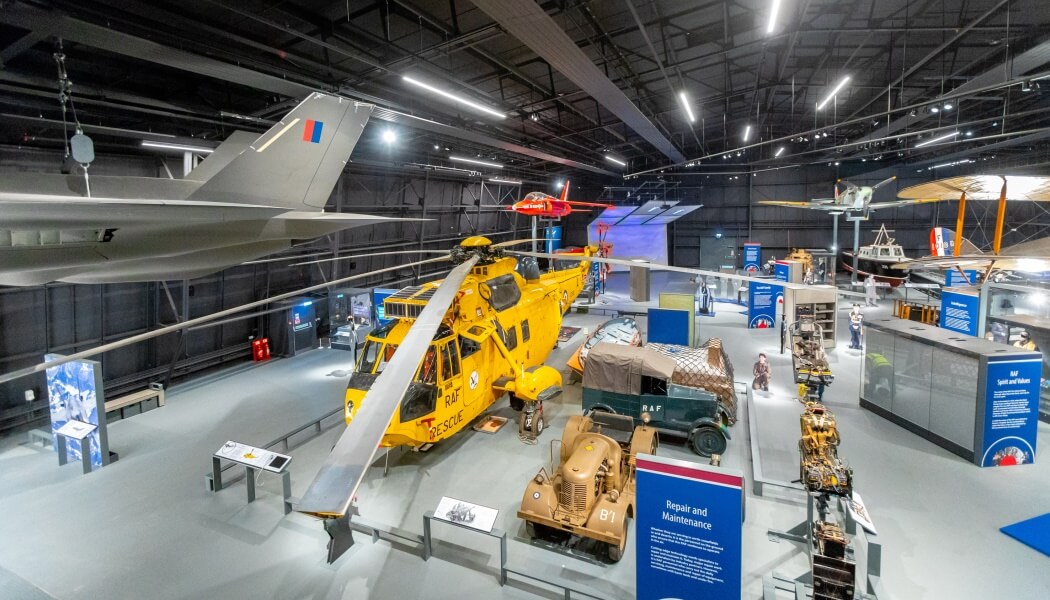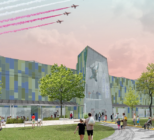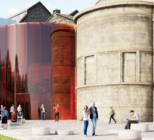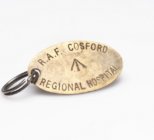What kind of tasks did The Hub complete at the RAF Museum in the last few weeks leading up to the opening?
The lead up to exhibitions openings is the busiest time for The Hub, with our team coordinating the final install of all packages to create the vision of the client and design team. Within Hanger 1 at Hendon, ‘The First 100 Years’ and ‘Now and The Future’, the last few weeks saw The Hub manage the installation of metal barriers, stairwell platforms, graphics, audio visual elements and physical interactives whilst supporting the Royal Air Force Museum’s collections team in their installation of the large missile and other objects!
During this time The Hub undertook a full suite of testing with our specialist sub-contractors as well as client direct appointments to ensure the highest level of visitor experience is achieved. This time period also required a high level of coordination with the Royal Air Force Museum’s teams to provide them with support in achieving their deadlines for the ‘non – exhibitioning’ spaces and providing full delivery and guidance on all the operational and maintenance aspects of the exhibition.
How many people from The Hub were on site and working on the final elements of the project?
To deliver the final installation of ‘The First 100 Years’ and ‘Now and The Future’, The Hub had a team of eight high quality joiners on site alongside our Project Managers and Site Managers and specialist sub – contractors working on the fit out elements throughout the final weeks. Our specialist sub – contractors during this time completed all final installs, testing and commissioning being on hand to provide support to parties ensuring fluid integrations. The Hub’s ability to coordinate and manage teams is highlighted by the relationships it builds and high quality service and product our clients receive.
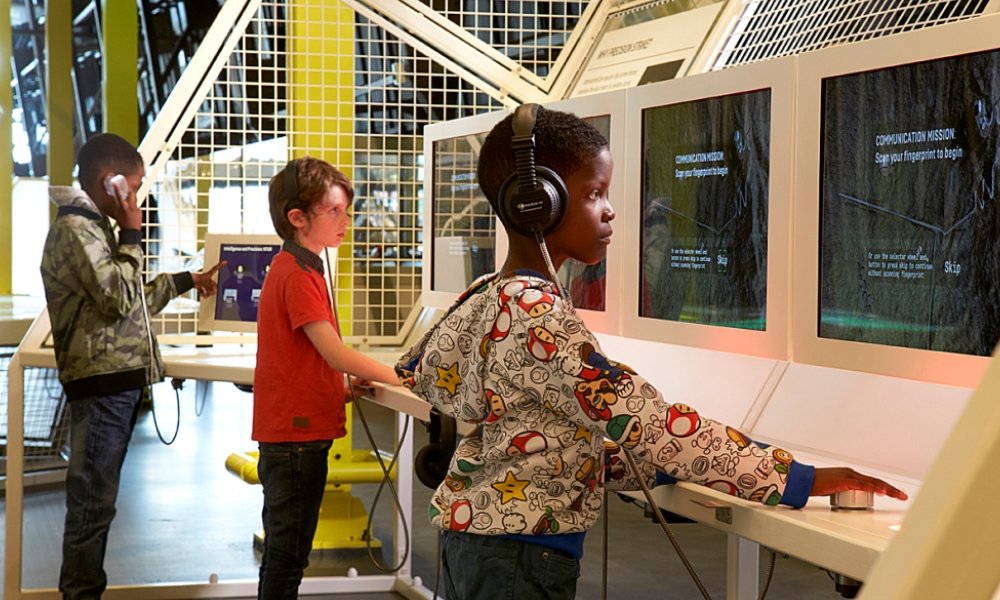
For the Royal Air Force Museum’s centenary projects The Hub appointed the following specialist sub-contractors:
- Power Data and Lighting | SI Electrical
- Audio Visual Hardware | Heritage Interactive
- Models and Interactives | Sirius Model Making
- Graphic Production and Installation | Displayways
- High Level Rigging | Unusual Rigging
The Hub appointed each specialist due to their wealth of knowledge and ability to evoke the ethos of collaborative working and each party worked openly with each other to deliver the project on budget and to programme.
What other companies did you work with in the final stage and what specialities did they bring?
In addition to The Hub’s team and it’s specialist sub-contractors the final installation saw our team work closely with the Royal Air Force Museum’s in-house teams and client appointed contractors, Unusual Rigging (Rigging), SDC (base build), Kin and Kingdom (digital experience). This interaction with other specialists was crucial in adding value to projects through the development of parallel working programmes.
What have been the challenges of the project during this final period and how did you overcome them?
The Hub’s main challenge during the lead up to opening was coordinating the installation of the exhibitions within both Hangars 1 and 6; given the occupancy of the various sub – contracting trades and the activities needing to be completed in a sequenced manner. The Hub overcame this by continually reviewing and prioritising the tasks in hand and through daily, open communication with all parties to ensure activities were being completed as required and that they did not impact on the operation of the live site. The Hub also had the foresight to have the correct teams in place to ensure the works carried out swiftly but to the high quality as required. A specific example of this was the requirement of a complete new floor in Hangar 6, although a late inclusion into the scheme The Hub worked with the museum to carefully sequence this in acknowledging that there was only a small window of opportunity between the large aircraft moves and the fit out of the exhibition.
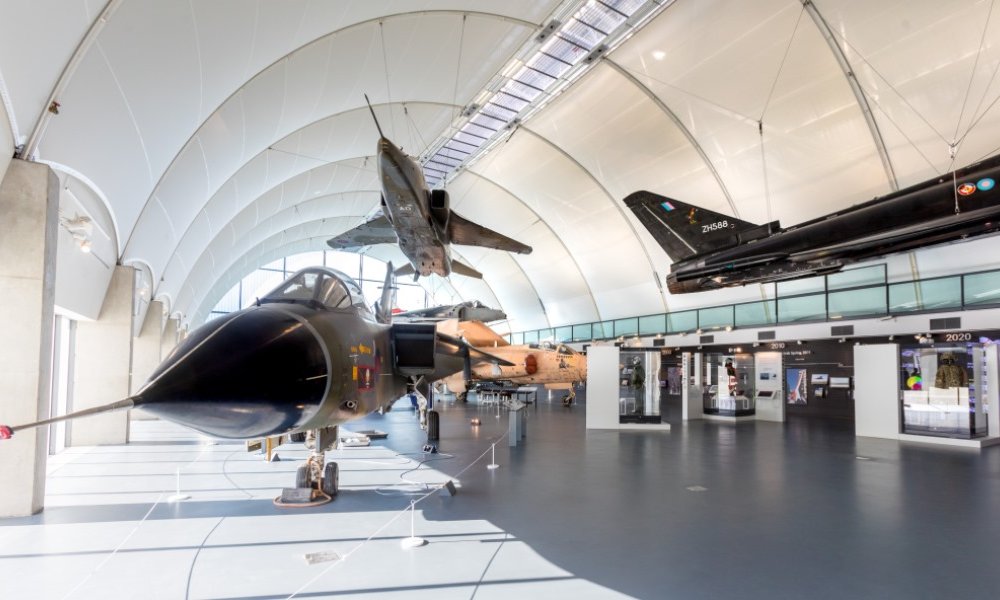
What were the key elements to the way you managed this project that ensured it was successfully delivered?
The Hub were appointed to develop and deliver design concepts from Met Studio and Kossmann.dejong, working with the Royal Air Force Museum and it’s client direct stakeholders to meet the needs of the museums stakeholders and HLF. The Hub’s clear, open and honest approach to the project ensured that expectations could be managed throughout the course of the project.
The Hub worked with Royal Air Force Museum to allow for provision of information and access to site to meet the needs of the marketing campaign and HLF requirements. This included undertaking educational days during the Construction Phase On Site with local schools maintaining the programme of works within a safe environment whilst children learnt about the Royal Air Force and tested the interactives. As part of the museums marketing campaign for the Centenary, The Hub worked with the client to arrange suitable dates within the on site programme for the BBC, ITV and various media outlets to film progress of works and to promote the new exhibitions.
Design Vision
Through the initial stages of the project, a key and important element was the successfully retaining Met Studio and Kossmann.dejong design vision for the scheme and implementing the exhibition structures to the concepts developed. When detailing the designs to full production drawings, we had to take into account various constraints of the hangers such as structural loadings and dimensional information gleaned during the completion of our detailed surveys. Ensuring visitor experience was not compromised and the highest quality of finish retained whilst mitigating the environmental challenges. Due to the scale of the exhibitions, metal was incorporated throughout for both aesthetics and as a structural requirement to support the interpretative media. The ability to review and work within the budgets as stated at the offset, we had to go though a journey of value engineering to ensure the vision for the desired scheme could still be realised. Again, working collaboratively with the museum, we identified those elements that could be omitted from the scheme without any detrimental impact to the visitor experience.
A key challenge identified was the number of high quality finishes in the two design concepts, by conducting protypes of the aesthetic of finishes. We produced exhibition structures in – house utilising our skilled workforce, state of the art machining and finishing facilities to deliver a high quality of finish against the specified materials. This prcess included the co-ordination and assembly of specialist components off-site, enabling installation on-site to be quicker and more efficient. We continually checked and reviewed each element to ensure it met expectations mitigating delays to programme and potenitally additional costs.
Exhibition infrastructure
The Hub believe that we have achieved this successfully whilst ensuring the exhibition infrastructure is one that is functional, operational and maintainable for the museum while adhering to the aesthetics desired. A good example of this was the futuristic frame structures in ‘RAFM: First to the Future’ – not only did we retain the look and feel of the concept, but we overcame challenges of stability and rigidity and the running of services provisions to facilitate the digital displays.
Another area in The Hub’s approach which added value to the project was our approach to programming and risk. Our team continually reviewed progress against programme with any challenges or issues arising identified and raised quickly, with multiple solutions offered to allow all parties to make informed decisions. This approach allowed The Hub to react efficiently and effectively to mitigate programme risks and additional costs to the project.

